Page 26 of 317
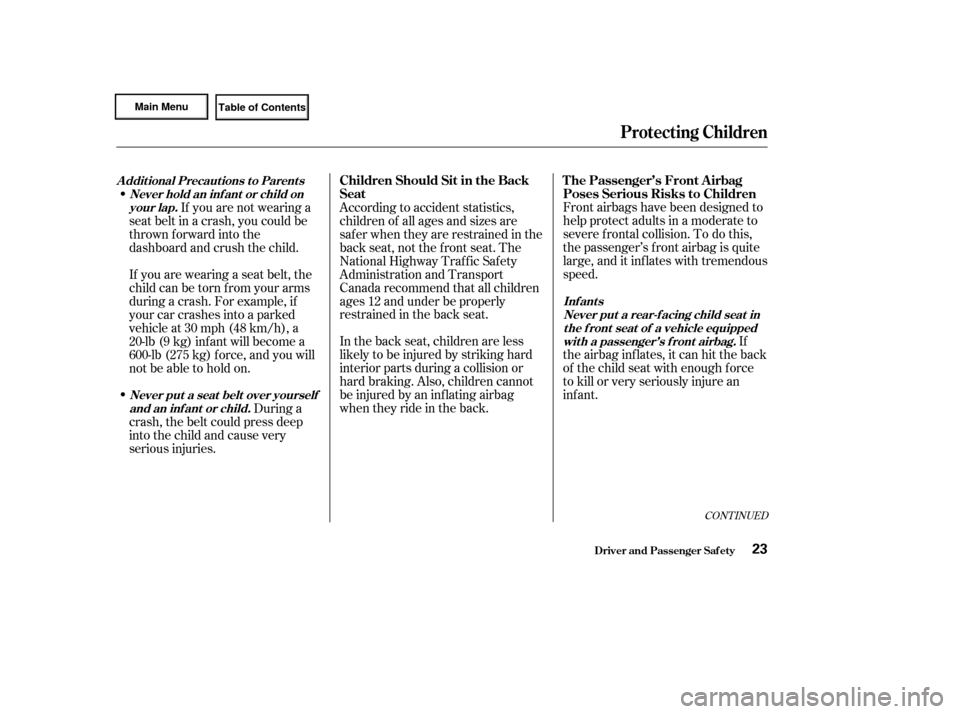
Front airbags have been designed to
help protect adults in a moderate to
severe f rontal collision. To do this,
the passenger’s f ront airbag is quite
large, and it inf lates with tremendous
speed.If
the airbag inf lates, it can hit the back
of the child seat with enough force
to kill or very seriously injure an
inf ant.
According to accident statistics,
children of all ages and sizes are
saf er when they are restrained in the
back seat, not the f ront seat. The
National Highway Traf f ic Saf ety
Administration and Transport
Canada recommend that all children
ages 12 and under be properly
restrained in the back seat.
In the back seat, children are less
likely to be injured by striking hard
interior parts during a collision or
hard braking. Also, children cannot
be injured by an inf lating airbag
when they ride in the back.
If you are not wearing a
seat belt in a crash, you could be
thrown f orward into the
dashboard and crush the child.
If youarewearingaseatbelt,the
child can be torn f rom your arms
during a crash. For example, if
your car crashes into a parked
vehicleat30mph(48km/h),a
20-lb (9 kg) inf ant will become a
600-lb (275 kg) f orce, and you will
not be able to hold on.
During a
crash, the belt could press deep
into the child and cause very
serious injuries.
CONT INUED
The Passenger’s Front Airbag
Poses Serious Risks to Children
Children Should Sit in the Back
Seat
Inf ant s
Never put a rear-f acing child seat int he f ront seat of a vehicle equippedwit h a passenger’s f ront airbag.
A ddit ional Precaut ions t o Parent s
Neverholdaninfantorchildonyour lap.
Never put a seat belt over yourselfand an inf ant or child.
Protecting Children
Driver and Passenger Saf ety23
Page 27 of 317
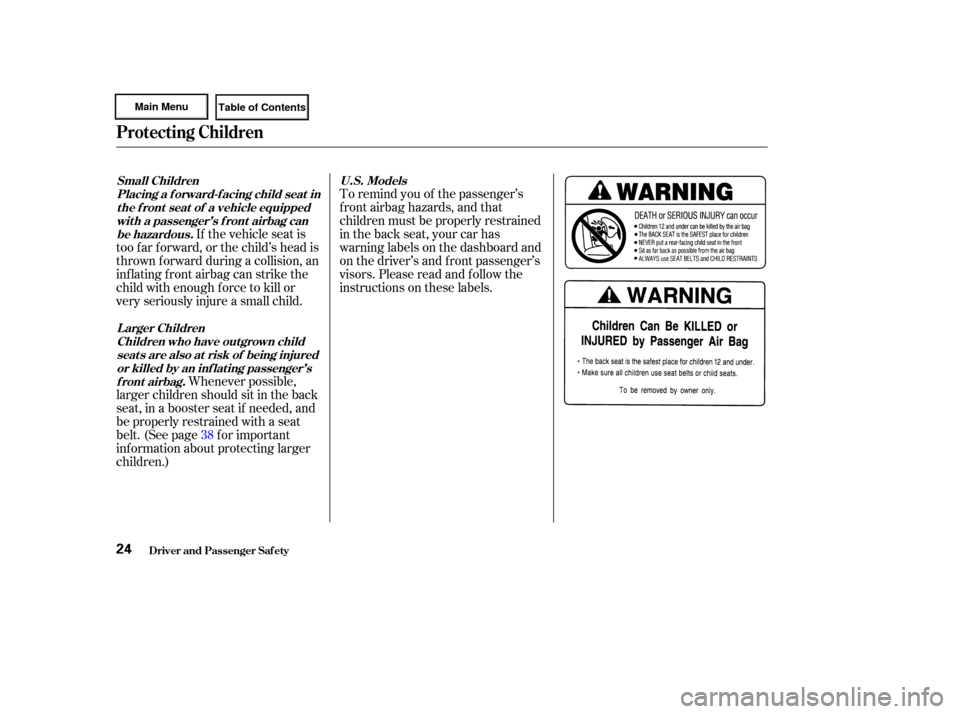
To remind you of the passenger’s
f ront airbag hazards, and that
children must be properly restrained
in the back seat, your car has
warninglabelsonthedashboardand
on the driver’s and f ront passenger’s
visors. Please read and f ollow the
instructions on these labels.
If the vehicle seat is
too far forward, or the child’s head is
thrown f orward during a collision, an
inflating front airbag can strike the
child with enough f orce to kill or
very seriously injure a small child.
Whenever possible,
larger children should sit in the back
seat, in a booster seat if needed, and
be properly restrained with a seat
belt. (See page f or important
inf ormation about protecting larger
children.) 38
U.S. Models
Small Children
Placing a f orward-f acing child seat int he f ront seat of a vehicle equippedwit h a passenger’s f ront airbag canbe hazardous.
Larger ChildrenChildren who have outgrown childseat s are also at risk of being injuredor killed by an inf lat ing passenger’sfront airbag.
Protecting Children
Driver and Passenger Saf ety24
Page 28 of 317
To remind you of the f ront airbag
hazards, your car has warning labels
on the driver’s and f ront passenger’s
visors. Please read and f ollow the
instructions on these labels.Your car has three seating positions
in the back seat where children can
be properly restrained.
If you ever have to carry more than
three children in your car:
Place the largest child in the f ront
seat, provided the child is large
enough to wear a seat belt
properly (see page ).
Move the vehicle seat as far to the
rear as possible (see page ).
Have the child sit upright and well
backintheseat(seepage ).
Make sure the seat belt is properly
positioned and secured (see page ). 38
1319
16
Protecting Children
Driver and Passenger Saf ety
If You Must Drive with Several
ChildrenCanadian Models
25
Page 29 of 317
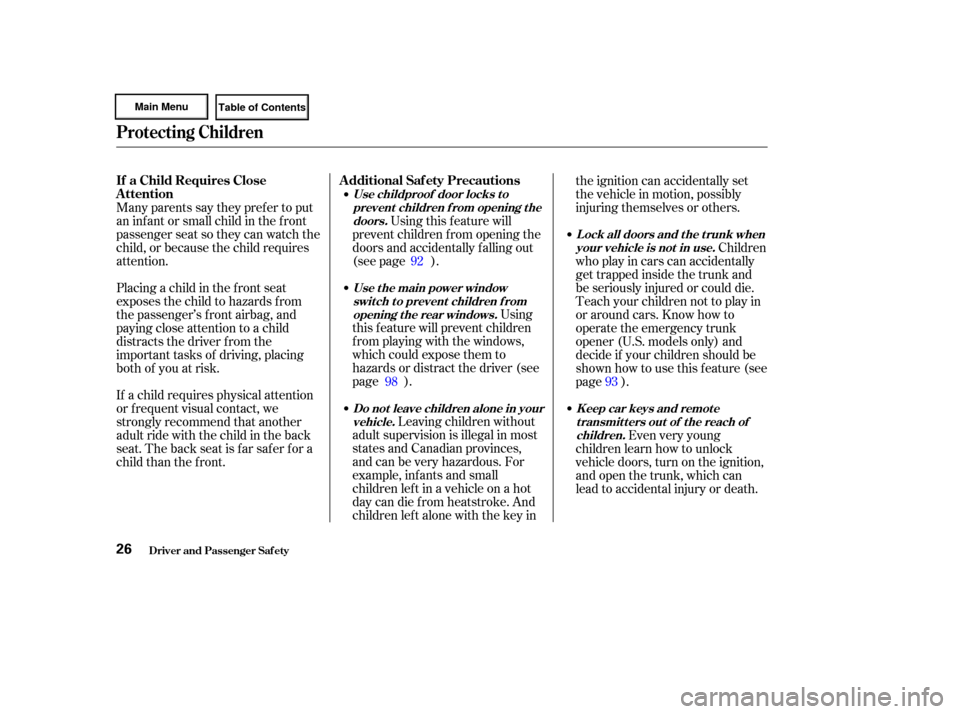
Leaving children without
adult supervision is illegal in most
states and Canadian provinces,
and can be very hazardous. For
example, inf ants and small
childrenleftinavehicleonahot
day can die f rom heatstroke. And
children lef t alone with the key in the ignition can accidentally set
the vehicle in motion, possibly
injuring themselves or others.
Using this f eature will
prevent children f rom opening the
doors and accidentally f alling out
(see page ).
Using
this f eature will prevent children
f rom playing with the windows,
which could expose them to
hazards or distract the driver (see
page ).
Many parents say they pref er to put
an inf ant or small child in the f ront
passenger seat so they can watch the
child, or because the child requires
attention.
Placing a child in the f ront seat
exposes the child to hazards f rom
the passenger’s f ront airbag, and
paying close attention to a child
distracts the driver f rom the
important tasks of driving, placing
both of you at risk.
If a child requires physical attention
or f requent visual contact, we
strongly recommend that another
adult ride with the child in the back
seat. The back seat is far safer for a
child than the front. Children
who play in cars can accidentally
get trapped inside the trunk and
be seriously injured or could die.
Teach your children not to play in
or around cars. Know how to
operate the emergency trunk
opener (U.S. models only) and
decide if your children should be
shown how to use this f eature (see
page ).
Even very young
children learn how to unlock
vehicle doors, turn on the ignition,
and open the trunk, which can
lead to accidental injury or death.
92
98 93
Protecting Children
Driver and Passenger Saf ety
Do not leave children alone in your
vehicle.
Use childproof door locks t o
prevent children f rom opening t hedoors.
Use t he main power windowswit ch t o prevent children f romopening t he rear windows. L ock all doors and t he t runk when
your vehicle is not in use.
K eep car keys and remot etransmitters out of the reach ofchildren.
Additional Saf ety Precautions
If a Child Requires Close
Attention
26
Page 32 of 317
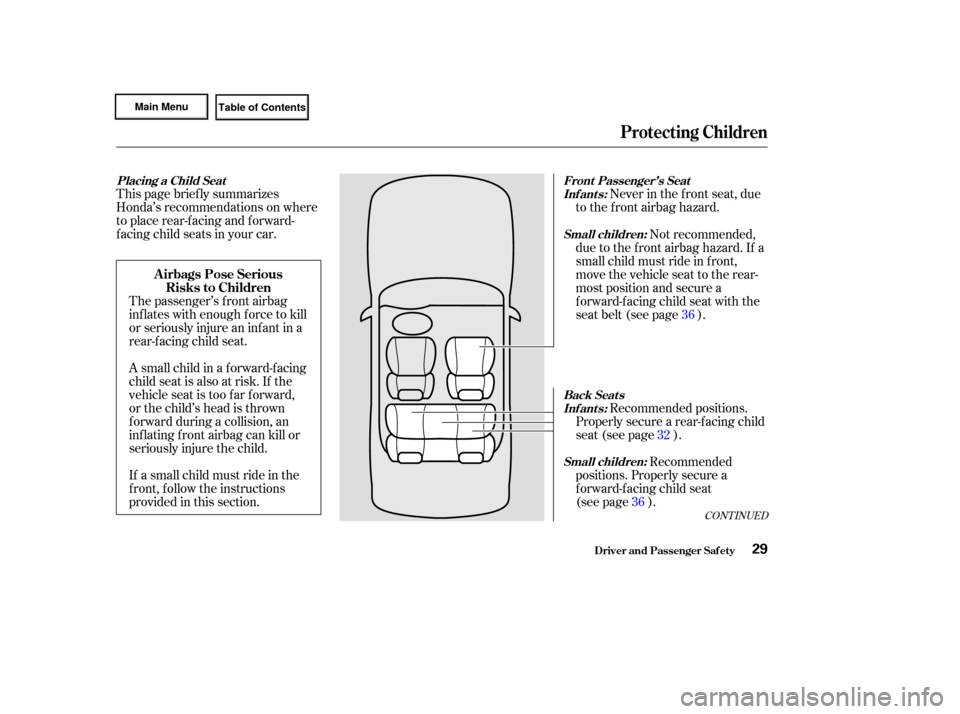
This page brief ly summarizes
Honda’s recommendations on where
to place rear-facing and forward-
f acing child seats in your car.Never in the f ront seat, due
to the f ront airbag hazard.
The passenger’s f ront airbag
inf lates with enough f orce to kill
or seriously injure an inf ant in a
rear-facing child seat.
A small child in a f orward-f acing
child seat is also at risk. If the
vehicle seat is too f ar f orward,
or the child’s head is thrown
f orward during a collision, an
inf lating f ront airbag can kill or
seriously injure the child.
If a small child must ride in the
f ront, f ollow the instructions
provided in this section. Recommended positions.
Properlysecurearear-facingchild
seat (see page ). Not recommended,
due to the f ront airbag hazard. If a
small child must ride in f ront,
move the vehicle seat to the rear-
most position and secure a
forward-facing child seat with the
seat belt (see page ).
Recommended
positions. Properly secure a
forward-facing child seat
(see page ). 36
32
36
CONT INUED
Placing a Child Seat Front Passenger’s Seat
Inf ant s:
Back Seat sInf ant s:
Small children:
Small children:
Airbags Pose SeriousRisks to Children
Protecting Children
Driver and Passenger Saf ety29
Page 34 of 317

Only a rear-f acing child seat provides
proper support f or a baby’s head,
neck, and back. Inf ants up to about
one year of age must be restrained in
a rear-f acing child seat.In this car, a rear-f acing child seat
can be placed in any seating position
in the back seat, but not in the front
seat.
Two types of seats may be used: a
seat designed exclusively f or inf ants,
or a convertible seat used in the rear-
f acing, reclining mode. If the passenger’s
f ront airbag inf lates, it can hit the
back of the child seat with enough
f orce to kill or seriously injure an
inf ant. If an inf ant must be closely
watched, we recommend that
another adult sit in the back seat
with the baby.
If placed
f acing f orward, an inf ant could be
very seriously injured during a
f rontal collision.
We recommend that an inf ant be
restrained in a rear-f acing child seat
until the inf ant is at least one year
old, reaches the seat maker’s weight
or height limit, and is able to sit up
without support.
CONT INUED
Protecting Inf ants
Child Seat T ype Rear-Facing Child Seat Placement
Never put a rear-f acing child seat inthe front seat.
Do not put a rear-f acing child seat ina f orward-f acing position.
Protecting Children
Driver and Passenger Saf ety31
Placing a rear-facing child seat
in the front seat can result in
serious injury or death if the
passenger’s front airbag inflates.
Always place a rear-facing child
seat in the back seat, not the
front.
Page 38 of 317
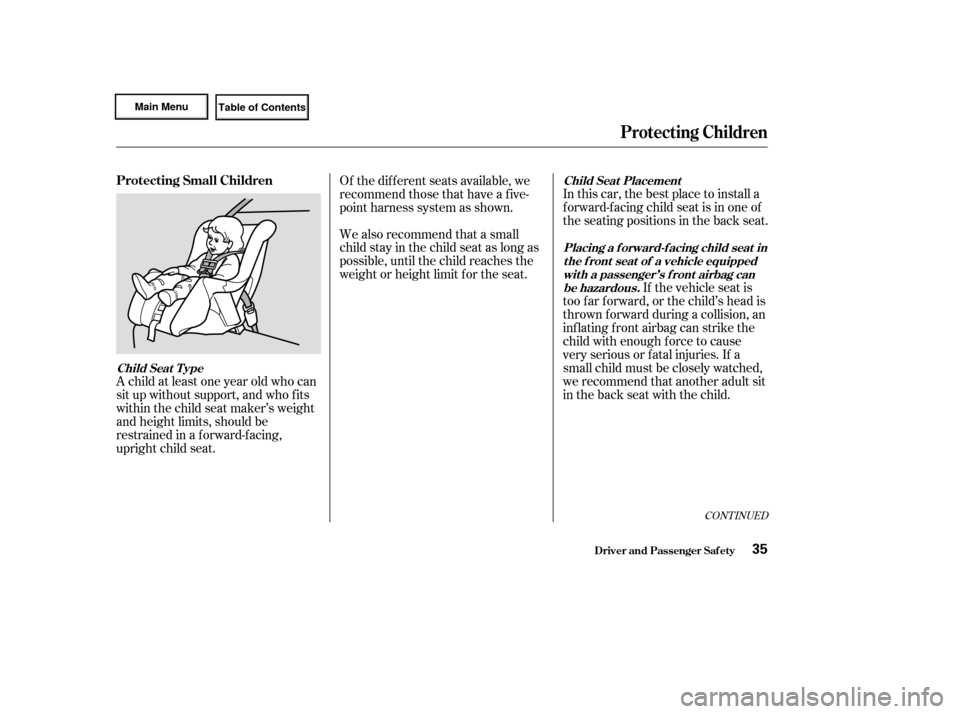
In this car, the best place to install a
f orward-f acing child seat is in one of
the seating positions in the back seat.If the vehicle seat is
too far forward, or the child’s head is
thrown f orward during a collision, an
inflating front airbag can strike the
child with enough f orce to cause
very serious or f atal injuries. If a
small child must be closely watched,
we recommend that another adult sit
in the back seat with the child.
We also recommend that a small
child stay in the child seat as long as
possible, until the child reaches the
weight or height limit f or the seat. Of the different seats available, we
recommend those that have a f ive-
point harness system as shown.
A child at least one year old who can
sit up without support, and who f its
within the child seat maker’s weight
and height limits, should be
restrained in a f orward-f acing,
upright child seat.
CONT INUED
Protecting Small Children
Child Seat T ype Child Seat Placement
Placing a f orward-f acing child seat int he f ront seat of a vehicle equippedwit h a passenger’s f ront airbag canbe hazardous.
Protecting Children
Driver and Passenger Saf ety35
Page 39 of 317
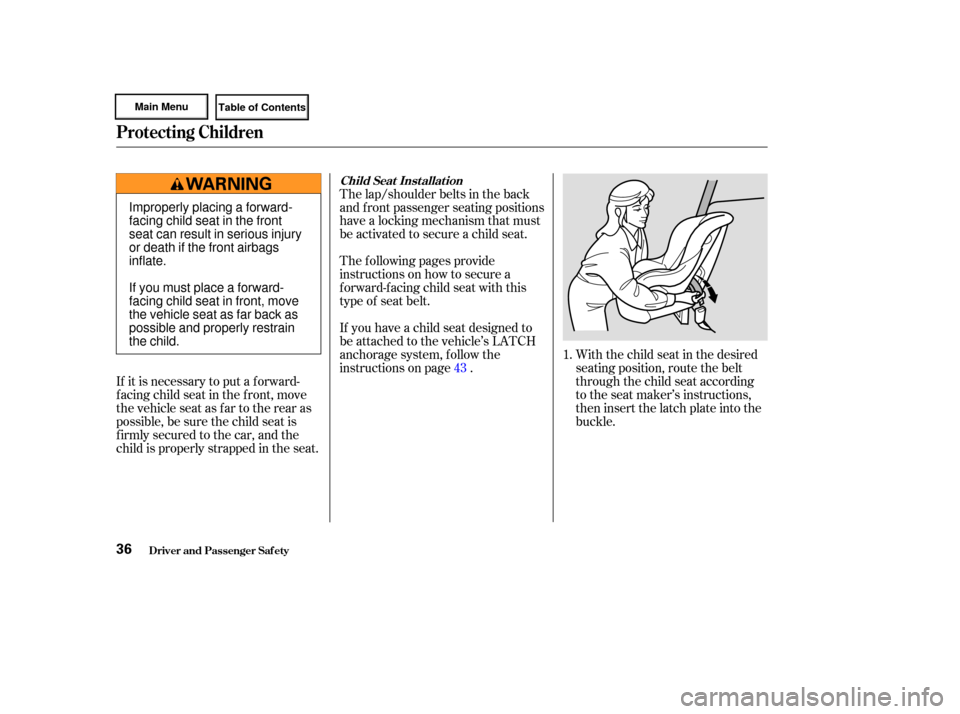
With the child seat in the desired
seating position, route the belt
through the child seat according
to the seat maker’s instructions,
then insert the latch plate into the
buckle.
The lap/shoulder belts in the back
and f ront passenger seating positions
have a locking mechanism that must
be activated to secure a child seat.
The f ollowing pages provide
instructions on how to secure a
f orward-f acing child seat with this
type of seat belt.
If it is necessary to put a f orward-
f acing child seat in the f ront, move
the vehicle seat as far to the rear as
possible, be sure the child seat is
f irmly secured to the car, and the
child is properly strapped in the seat. If you have a child seat designed to
be attached to the vehicle’s LATCH
anchorage system, follow the
instructions on page .
1.
43
Child Seat Inst allat ion
Protecting Children
Driver and Passenger Saf ety36
Improperly placing a forward-
facing child seat in the front
seat can result in serious injury
or death if the front airbags
inflate.
Ifyoumustplaceaforward-
facing child seat in front, move
the vehicle seat as far back as
possible and properly restrain
the child.